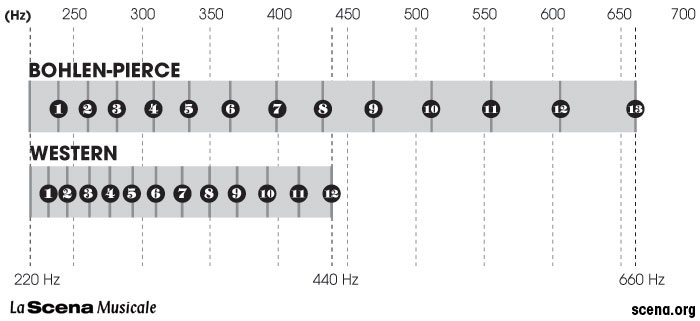
The story of microtonality might be as old as music itself. In non-Western music traditions, e.g. Indian Carnatic music or Arabic melismas, its use is commonplace. Western concert music, in contrast, is built on fixed pitches no closer together than the semitone and now commonly played with twelve-tone equal temperament, a device that effectively ‘rounded off’ minute tone differences. While still confined to its margins, microtonality is gaining new acceptance in our culture, as witnessed by a steadily growing body of works exploring these timbral possibilites. The Russian Ivan Wyschnegradsky was a true pioneer in this respect, writing piano works for one or two pianos tuned in quartertones. Nowadays, there are festivals devoted to it, and works requiring tunings in eighth and sixteenth tones!
A Chance Discovery
Even within the history of microtonality, the Bohlen-Pierce system is a rather new entry, and one with a pretty offbeat history at that. For starters, it was devised not by a musician but by an engineer, one Heinz Bohlen. In the early 1970s, this specialist in communications and microwave electronics in Germany happened to offer his services to record concerts performed by the students of Hamburg’s Musikhochschule and their professors. Bohlen was intrigued by the fact that all the music was created from an octave comprised of 12 steps. When he asked them about this, musicians seemed at a loss for an answer, as they were more interested in using these materials at their disposal than actually questioning their properties.
Combing through the literature, he would find an answer in the relationships of tones forming a triad (known in the trade as 4:5:6, or unison:third:fifth). By tinkering with the pitch levels and generating a 3:5:7 combination instead, he stumbled upon a new scale of 13 steps spanning a 12th rather than the usual octave. What this means is that every step of the new scale is equivalent to ¾ of a tone in our traditional scale, a.k.a. ‘diatonic.’ Mathematically then, it takes three semitones (3×1/2) to create a minor third (C,D,Eb), whereas it takes only two ¾ tones of the Bohlen-Pierce system to achieve that interval, at least something very close to it. To prove his discovery, Bohlen decided to construct an instrument, his choice being an electronic organ. After a year’s work, and with help from fellow engineers, he had achieved his goal. In 1974, he convinced a professional organist to ‘road test’ it, and the musician managed to find a number of attractive sounding chords on it in spite of its rather primitive sound. This discovery, however, found limited acceptance in the music community, and was restricted to Germanic speaking-countries, thus going unnoticed in the community at large.
Twists of Fate
But the story does not end there. Kees van Prooijen in neighbouring Holland was an engineer by trade like Bohlen, yet had a background in music theory. In 1978, independently of the German, he proposed an equal tempered version of the same scale, this one enabling consonance within higher harmonics. Oddly enough, he would not publish his findings until the mid-1990s through an odd twist of fate.
Enter then John Robinson Pierce, the second ‘official’ discoverer of this system. Coincidentally, this Californian was also an engineer; in fact he’s remembered as the father of the communications satellite and godfather of the transistor. Yet he was also well versed in music theory and acoustic science. Not too long after making the same discovery, in 1984, and publishing his own research, he was made aware of Bohlen’s work, which led to the compounding of the names as the designation for the scale. And by another stroke of fate, all three parties involved in the find wound up living within miles of each other in the Bay Area in the mid 1990s. Yet Bohlen and van Prooijen crossed paths on only one single occasion in 1996, while Pierce repeatedly refused invitations to meet the other two.
The Bohlen-Pierce system has slowly found its way into the realm of musical creation. In fact the first musical program of works composed in that system occurred here in Canada in 2008, at the University of Guelph, one of them penned by a Montreal-based composer and percussionist, Todd Harrop. As for instruments, there is now a luthier in Boston who makes guitars tuned in that system as well as a maker of clarinets, Stephen Fox in Toronto, who has built a dozen of them, including a unique tenor model for a German musician, Nora-Louise Müller.
• Read more here about Stephen Fox’s clarinets.
• Read more on the history of the B.P. system at: www.huygens-fokker.org/bpsite













